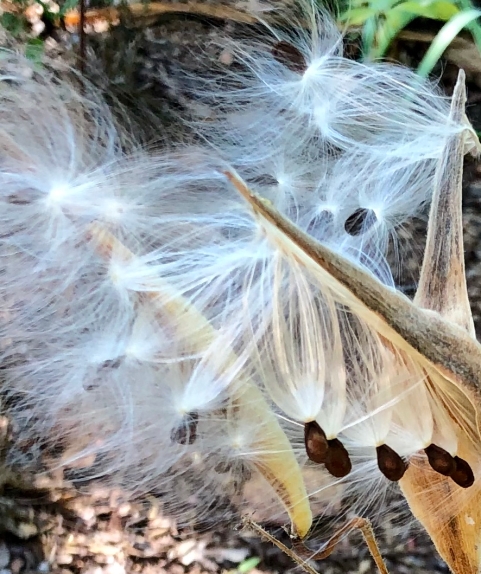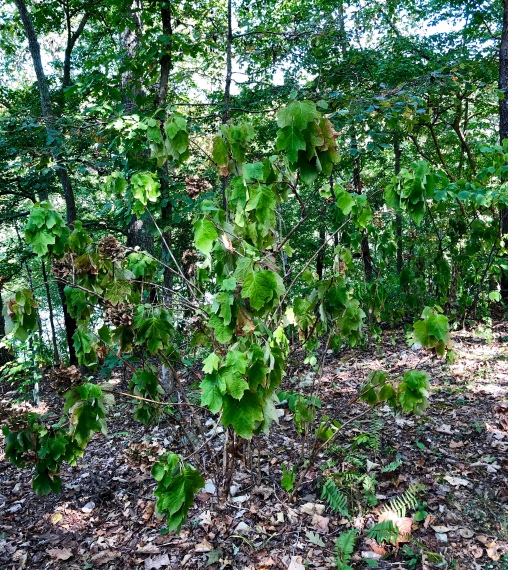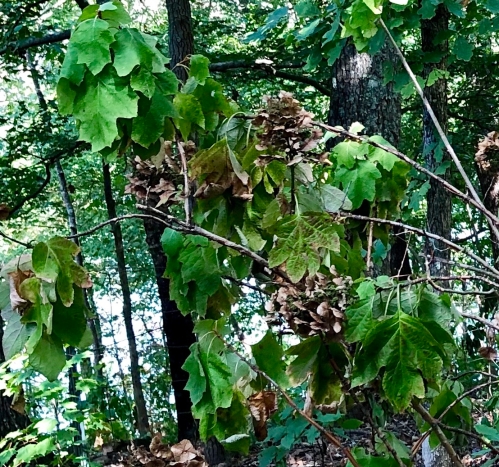My six plants for today include some purple blooms, some fuzzy seeds, and discouraging visual evidence of our current Alabama drought and unseasonably high temperatures. But before the disheartening image of a dehydrated and stressed hydrangea, let me remind others that they can see photos of gardens in other climates, in fact in other seasons, by going to The Propagator’s site and following links in the comments. Here is the URL for guidelines for taking part. And, now, here are my six for today.
1. Obedient plant, or Physostegia virginiana, I mentioned in my last post as it was beginning to bloom, but it is in full bloom now. It is also one of the plants I’ve worked at keeping alive with frequent watering–both for the sake of the garden and the bees, as can be seen in the featured image and in the first image below. The inflorescence is made of several light purple tubular flowers delicately stippled inside with deeper purple spots. All in all, it is a dependable plant to look forward to in the fall.
2. Except for some chartreuse coleous and a few scraggly merigolds, the obedient plant and the sedum ‘Autumn Joy’ (Hylotelephium herbstfreude) below provide just about the only color I have at the moment–aside from withered green and crispy brown.
3. Moving from color to texture, I think the seed pods of butterfly weed (Asclepias tuberosa) are absolutely lovely as they open–fully worthy of a “Silent Sunday” entry. I am trying to increase the number of natives I have in the garden, so I am definately going to gather some of the seeds and store them in the refrigerator for a few months. Then I’ll plant the seeds in starter pots until transplanting them when Alabama is frost free in the spring. Given the current climate conditions, though, it is hard to imagine frost in the garden at all.

4. Not nearly as graceful as all the milkweed-related wind-carried gliders like those above, the seed heads of Zebra grass, or Miscanthus sinensis ‘Zebrinus’, are nevertheless interesting. Of course, Zebra grass itself adds interest to the garden with its tall dark green leaves with lighter green vertical stripes and arched growth pattern. It, like the butterfly weed, is a perennial but certainly not a native. Reportedly, this import from Japan can be invasive; however, while I have had a clump spread slowly out from its base, I have seen no aggressive invasion.
5. Miscanthus sinensis ‘Adagio’ is the third of my fuzzy entries. Its seed heads, although more feathery, are not significantly different than those of Zebra grass, but the plant’s profile is quite different. Clumping in habit, its blades are much thinner and not nearly as tall. I’m using it in alternation with young mophead hydrangeas (Hydrangea macrophylla) to edge the driveway; however, it performs better in group plantings. I think next year it will be replaced with the limelight hydrangeas I propagated this past spring.
As can be seen in the two photos above, the ground is quite dry and littered with leaves brown from drying out rather than from any seasonal color change. And that brings me to my final and disheartening entry.
6. The Oakleaf hydrangea below is indicative of what my entire lot looks like, or a least any place I have not been dutifully watering. Notice the nearly flattened ferns in the bottom right of the photo.

A closer look at the wilted leaves and desiccated flower heads of the hydrangea is worthwhile. The lovely, large white flower heads of the Oakleaf hydrangea Central and Northern Alabama prides itself on normally fade by this time of year, but their shape holds and the color variants progress from white to pinkish brown to burnished-brown accompanied by bronzed leaves. What we see below is burnt petals and leaf damage due to dehydration and heat.

Most of Alabama is under drought conditions ranging from mild to severe at the moment. At Highland Lake there has been only one day of beneficial rain fall since the last week in August. Unfortunately, there is no significant rain in the forecast for this area in the next week, which takes us into the first week in October, typically the driest month in the State.
While I’d like to think of this rainless period as an aberration, an anomaly, I along with others in this area remember the drought of 2016 that brought about the demise of many shrubs and trees. I know that the end of the summers of 2017 and 2018 suffered from a lack of rain. I am also aware of climate predictions for the State: increased days with temperatures of 95 degrees Fahrenheit (35C) and above (the temperature highs forecasted for the next week range 93 to 96), extended periods of summer drought exacerbated by the heat, and more severe weather events.
So, I know that this is no aberration, no abnormality. I will have to become a wiser, more judicious gardener, focus on native and drought tolerant plants, and enjoy the predicted more frequent springs rains.












Fingers crossed for rain soon. Those seed heads look lovely though, especially the really wispy one.
LikeLiked by 1 person
I am sorry I missed it all last week. It will be a while before I catch up with today. Physostegia virginiana is pretty rad. I have never met it, and have not seen Physostegia venusta in many years. It seems that those in the East have always been familiar with both.
LikeLiked by 1 person